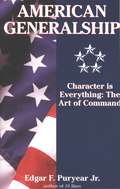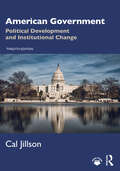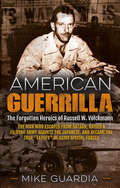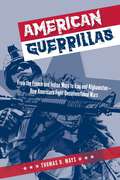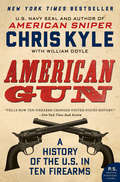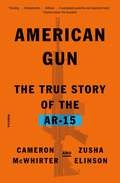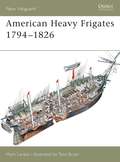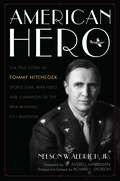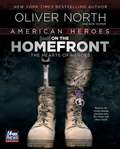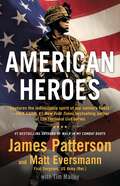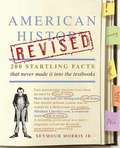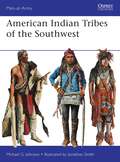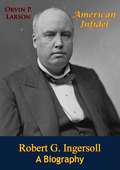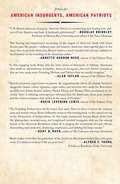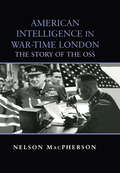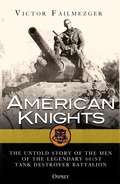- Table View
- List View
American Generalship: Character Is Everything: The Art of Command
by Edgar PuryearAmerica's top military leaders are scrutinized as Puryear ponders what prepared our generals for the terrible responsibilities they bore during World War II, Korea, Vietnam, the Gulf War and on to today.
American Government: Political Development and Institutional Change
by Cal JillsonHow politics in America works today, how it got that way, and how it’s likely to change through reform—these are the themes that pervade every chapter of Cal Jillson’s highly lauded American Government: Political Development and Institutional Change. Even in the midst of current challenges, America’s past is present in all aspects of the contemporary political system. Jillson uses political development and the dynamics of change as a thematic tool to help students understand how politics works now—and how institutions, participation, and policies have evolved over time to produce the contemporary political environment. In addition, Jillson helps students think critically about how American democracy might evolve further, focusing in every chapter on reform and further change. New to the 12th Edition: Assesses the characteristics and results of the Trump administration and the policy and tonal changes of the early Biden adminstration. Describes numerous ways in which the American political system has been affected by the Covid-19 pandemic Assesses the implications of the January 6, 2021 attack on the Capitol and what it implies for our political culture and partisan politics. Assesses the implication of "fake news" and "the move to mobile" for our politics. Explores the evidence for increasing polarization in public opinion, voting behavior, and the work of Congress and the courts.. Details the impact that the Russian invasion of Ukraine had on President Biden’s attempt to rebuild U.S. national security alliances.
American Government: Political Development and Institutional Change
by Cal JillsonHow politics in America works today, how it got that way, and how it’s likely to change through reform—these are the themes that pervade every chapter of Cal Jillson’s highly lauded American Government: Political Development and Institutional Change. Even in the midst of current challenges, America’s past is present in all aspects of the contemporary political system. Jillson uses political development and the dynamics of change as a thematic tool to help students understand how politics works now—and how institutions, participation, and policies have evolved over time to produce the contemporary political environment. In addition, Jillson helps students think critically about how American democracy might evolve further, focusing in every chapter on reform and further change.New to the Thirteeenth Edition Assesses the results of the Biden administration and the impact on the 2024 campaign of Biden’s unexpected replacement by Kamala Harris at the top of the ticket. Describes numerous ways in which the American political system has been affected by recovery from the Covid-19 pandemic, the demise of Roe v. Wade, inflation, and the border. Assesses the implications of the January 6, 2021 attack on the Capitol, the Trump trials, and what they mean for our political culture and partisan politics. Assesses the implication of "fake news" and "the move to mobile" for our politics.Explores the evidence for increasing polarization in public opinion, voting behavior, and the work of Congress and the courts. Details the impact that the Russian invasion of Ukraine and the war in Israel and Gaza had on U.S. foreign policy and national security alliances.
American Grand Strategy in the Mediterranean during World War II
by Andrew BuchananThis book offers a thorough reinterpretation of U. S. engagement with the Mediterranean during World War II. Andrew Buchanan argues that the United States was far from being a reluctant participant in a peripheral theater, and that Washington had a major grand-strategic interest in the region. By the end of the war the Mediterranean was essentially an American lake, and the United States had substantial political and economic interests extending from North Africa, via Italy and the Balkans, to the Middle East. This book examines the military, diplomatic, and economic processes by which this hegemonic position was assembled and consolidated. It discusses the changing character of the Anglo-American alliance, the establishment of post-war spheres of influence, the nature of presidential leadership, and the common interest of all the leaders of the Grand Alliance in blocking the development of potentially revolutionary movements emerging from the chaos of war, occupation, and economic breakdown.
American Guerrilla: The Forgotten Heroics of Russell W. Volckmann—the Man Who Escaped from Bataan, Raised a Filipino Army against the Japanese, and Became the True “Father” of Army Special Forces
by Mike GuardiaA main selection of the Military Book Club and a selection of the History Book Club With his parting words, "I shall return," General Douglas MacArthur sealed the fate of the last American forces on Bataan. Yet one young Army Captain named Russell Volckmann refused to surrender. He disappeared into the jungles of north Luzon where he raised a Filipino army of more than 22,000 men. For the next three years he led a guerrilla war against the Japanese, killing more than 50,000 enemy soldiers. At the same time he established radio contact with MacArthur's headquarters in Australia and directed Allied forces to key enemy positions. When General Yamashita finally surrendered, he made his initial overtures not to MacArthur, but to Volckmann. This book establishes how Volckmann's leadership was critical to the outcome of the war in the Philippines. His ability to synthesize the realities and potential of guerrilla warfare led to a campaign that rendered Yamashita's forces incapable of repelling the Allied invasion. Had it not been for Volckmann, the Americans would have gone in "blind" during their counter-invasion, reducing their efforts to a trial-and-error campaign that would undoubtedly have cost more lives, materiel, and potentially stalled the pace of the entire Pacific War. Second, this book establishes Volckmann as the progenitor of modern counterinsurgency doctrine and the true "Father" of Army Special Forces--a title that history has erroneously awarded to Colonel Aaron Bank of the European Theater of Operations. In 1950, Volckmann wrote two army field manuals: Operations Against Guerrilla Forces and Organization and Conduct of Guerrilla Warfare, though today few realize he was their author. Together, they became the US Army's first handbooks outlining the precepts for both special warfare and counter-guerrilla operations. Taking his argument directly to the army chief of staff, Volckmann outlined the concept for Army Special Forces. At a time when US military doctrine was conventional in outlook, he marketed the ideas of guerrilla warfare as a critical force multiplier for any future conflict, ultimately securing the establishment of the Army's first special operations unit--the 10th Special Forces Group. Volckmann himself remains a shadowy figure in modern military history, his name absent from every major biography on MacArthur, and in much of the Army Special Forces literature. Yet as modest, even secretive, as Volckmann was during his career, it is difficult to imagine a man whose heroic initiative had more impact on World War II. This long overdue book not only chronicles the dramatic military exploits of Russell Volckmann, but analyzes how his leadership paved the way for modern special warfare doctrine. Mike Guardia, currently an officer in the US 1st Armored Division is also author of Shadow Commander, about the career of Donald Blackburn, and an upcoming biography of Hal Moore.
American Guerrillas: From the French and Indian Wars to Iraq and Afghanistan—How Americans Fight Unconventional Wars
by Thomas D. MaysAmerican Guerrillas is a compelling narrative history of how Americans have fought unconventional warfare from the French and Indian Wars and the Revolution through the anti-insurgent campaigns of the wars in Iraq and Afghanistan. A timely volume, the author provides the reader with a concise and engaging story of how the American approach to guerrilla warfare has been molded and executed, and how these small scale engagements have been integral to the success of our nation&’s larger battles. The conventional view of popular American military history has been focused upon large-scale conflicts. American Guerrillas will attract history buffs as it puts guerrilla warfare into the larger context.
American Gun: A History of the U.S. in Ten Firearms
by William Doyle Chris KyleChris Kyle--fallen hero and #1 bestselling author of American Sniper--reveals how ten legendary guns forever changed U.S. history. At the time of his tragic death in February 2013, former Navy SEAL Chris Kyle, the top sniper in U.S. military history, was finishing one of the most exciting missions of his life: a remarkable book that retold American history through the lens of a hand-selected list of firearms. Kyle masterfully shows how guns have played a fascinating, indispensable, and often underappreciated role in our national story. "Perhaps more than any other nation in the world," Kyle writes, "the history of the United States has been shaped by the gun. Firearms secured the first Europeans hold on the continent, opened the frontier, helped win our independence, settled the West, kept law and order, and defeated tyranny across the world. "Drawing on his unmatched firearms knowledge and combat experience, Kyle carefully chose ten guns to help tell his story: the American long rifle, Spencer repeater, Colt . 45 revolver, Winchester rifle, Springfield 1903 rifle, Thompson sub-machine gun, 1911 pistol, M1 Garand, . 38 Special police revolver, and the M-16 rifle platform Kyle himself used as a SEAL. Through them, he revisits thrilling turning points in American history, including the single sniper shot that turned the tide of the Revolutionary War, the firearms designs that proved decisive at Gettysburg, the "gun that won the West," and the weapons that gave U. S. soldiers an edge in the world wars and beyond. This is also the story of how firearms innovation, creativity, and industrial genius has constantly pushed American history--and power--forward. Filled with an unforgettable cast of characters, Chris Kyle's American Gun is a sweeping epic of bravery, adventure, invention, and sacrifice.
American Gun: The True Story of the AR-15
by Cameron McWhirter Zusha ElinsonA finalist for the Los Angeles Times Book Prize“A magisterial work of narrative history and original reportage . . . You can feel the tension building one cold, catastrophic fact at a time . . . A virtually unprecedented achievement.” —Mike Spies, The New York Times Book Review (Editors’ Choice)A Washington Post top 50 nonfiction book of 2023 | Short-listed for the Zócalo Book PrizeOne of The New York Times’ 33 nonfiction books to read this fall | One of Esquire’s best books of fall | A Kirkus Reviews best nonfiction book of 2023Named a most anticipated book of the fall by The Washington Post, Los Angeles Times, and BloombergAmerican Gun: The True Story of the AR-15 presents the epic history of America’s most controversial weapon.In the 1950s, an obsessive firearms designer named Eugene Stoner invented the AR-15 rifle in a California garage. High-minded and patriotic, Stoner sought to devise a lightweight, easy-to-use weapon that could replace the M1s touted by soldiers in World War II. What he did create was a lethal handheld icon of the American century.In American Gun, the veteran Wall Street Journal reporters Cameron McWhirter and Zusha Elinson track the AR-15 from inception to ubiquity. How did the same gun represent the essence of freedom to millions of Americans and the essence of evil to millions more? To answer this question, McWhirter and Elinson follow Stoner—the American Kalashnikov—as he struggled mightily to win support for his invention, which under the name M16 would become standard equipment in Vietnam. Shunned by gun owners at first, the rifle’s popularity would take off thanks to a renegade band of small-time gun makers. And in the 2000s, it would become the weapon of choice for mass shooters, prompting widespread calls for proscription even as the gun industry embraced it as a financial savior. Writing with fairness and compassion, McWhirter and Elinson explore America’s gun culture, revealing the deep appeal of the AR-15, the awful havoc it wreaks, and the politics of reducing its toll. The result is a moral history of contemporary America’s love affair with technology, freedom, and weaponry.Includes 8 pages of black-and-white images.
American Hangman: MSgt. John C. Woods: The United States Army’s Notorious Executioner in World War II and Nürnberg
by French L. MacLeanThe first biography of MSgt. John C. Woods, infamous US Army hangman of the Nuremberg trials MacLean meticulously separates fact from the mythology surrounding this enigmatic figure This is a follow-on book to The Fifth Field, winner of the 2013 Richard G. Trefry Award from the Army Historical Foundation
American Haven
by Elizabeth YatesTeenagers Michael and Meredith Lamb find new friends and mountains to climb when they travel from war-torn London to New Hampshire with their Uncle Tony during World War II.
American Heavy Frigates 1794-1826
by Mark LardasBy 1805 the 44-gun frigate was probably viewed as a failed experiment whilst the 38-gun frigate was viewed as the vessel of the future. Ten years later every navy was building 44-gun frigates and today it is viewed as the symbol of the Napoleonic-era cruiser. This remarkable transformation resulted from the performance of three ships – the Constitution, United States, and President – 44-gun frigates built for the United States Navy between 1794 and 1799. Their victories in the naval War of 1812, as well as their performance against the Barbary Pirates, caught the imagination of the world – and spurred all navies into re-examining the class.
American Heritage History of Flight
by Arthur GordonPeople dreamed of flight for thousands of years. When we finally took to the skies, a new world opened up. This sweeping, superbly researched history from American Heritage details how various pioneers and innovators - from the Wright Brothers to Chuck Yeager - helped lift us into the sky.
American Hero: The True Story of Tommy Hitchcock--Sports Star, War Hero, and Champion of the War-Winning P-51 Mustang
by Nelson W. AldrichBorn to wealth, adventuresome in spirit, shrewd in business, gallant in war, and a beau ideal of his class, Tommy Hitchcock was the epitome of the American hero, a legend even in his own time. To Scott Fitzgerald, Tommy embodied the ideal of the aristocratic man of action, basing two of his characters loosely on Tommy.Tommy joined the Lafayette Escadrille during WWI at the age of 17. He was shot down, captured by the Germans, and then made a dramatic escape to Switzerland. Within a few years after the war, he had become one of the stars of the &“Golden Age of Sport.&” In the 20s and 30s, Tommy dominated polo more decisively than Bobby Jones did golf or Babe Ruth did baseball. Settling in New York with his growing family, he became an investment banker and threw famous parties in Great Neck, Long Island, which attracted the rich and famous as well as celebrities such as Scott and Zelda Fitzgerald. Always impecunious, the Fitzgeralds were easy to attract to a lavish party, but not so easy to convince to leave. When America entered WWII, Tommy re-entered the service, but was told he was &“too old&” for combat flying. He became the biggest booster of the new P-51, then in development, becoming instrumental in convincing the Army to build it to protect Flying Fortresses on their bombing raids over Germany. We were losing hundreds of the heavy bombers to Luftwaffe Messerschmitt&’s because we didn&’t have a fighter that could reach Germany with the bombers. The P-51 was a game-changer. Hermann Goering, commander of the Luftwaffe, told his American interrogators after the war that when he saw P-51s flying unopposed in the skies over Berlin, he knew the gig was up and Germany would lose the war. Tragically, on April 18, 1944, Tommy died test-flying one of the new P-51s in England. He will forever be an American hero.
American Heroes on the Homefront
by Oliver NorthCombat-decorated Marine Oliver North delivers a riveting firsthand account of the extraordinary young American volunteers—the best and bravest of their generation—who stepped forward to defend us from radical Islamic terror. For more than a dozen years North and his award-winning documentary team from FOX News Channel’sWar Stories have traveled to the frontlines of the War on Terror to profile the dedicated men and women who serve our nation in harm’s way and chronicle what it truly means to be a hero. This time, he follows them from the battlefield to the homefront and finds extraordinary inspiration in their triumph over life-altering adversity. In this new volume of his New York Times bestselling American Heroes series, North describes in vivid detail the breathtaking courage, steadfast commitment, and resilient strength of those who serve—and those who love them. The term “selfless devotion” may be a cliché to many in our modern culture—but not to the men and women on the pages of this book. Their stories resound with bravery, a warrior ethos, and spiritual strength that ought to encourage us all. Heroes are people who knowingly place themselves at risk for the benefit of others. They give of themselves, literally and physically. Since the terror attack of 9-11- 01, more than 2 million young Americans have volunteered to serve in difficult and dangerous places. No military force in history has been asked to do more than those who have served and sacrificed in this long fight. They are American heroes. So too are their loved ones here at home. These are their stories.
American Heroes: From the #1 bestselling authors of Walk in My Combat Boots
by James Patterson Matt EversmannFrom the authors of Walk in My Combat Boots, “American Heroes is a gripping collection of firsthand accounts…capturing the indomitable spirit of our nation’s finest&” (Jack Carr, #1 New York Times bestselling author of The Terminal List series). U.S. soldiers who served in overseas conflicts—from World War II, Korea, and Vietnam to Iraq and Afghanistan—share true stories of the actions that earned them some of America’s most distinguished military medals, up to and including the Medal of Honor. They never acted alone, but always in the spirit of camaraderie, patriotism, and for the good of our beloved country. There has never been a better time for all of us to think about duty, sacrifice, and what it means to be an American hero. <br><b>New York Times Bestseller</b></br>
American Heroes: In The Fight Against Radical Islam
by Chuck Holton Oliver NorthI have the best job in all broadcasting. Soldiers, sailors, airmen, Guardsmen, and Marines—those who fight America's wars—are my only "beat." I hang around with heroes for a living.
American Heroes: On the Homefront
by Oliver NorthFrom the New York Times bestselling author of Heroes Proved, a moving collection of "straightforward, honest testimonials to the courage American troops display on and off the battlefield" (Kirkus Reviews).For more than a dozen years, combat-decorated Marine Oliver North and his award-winning documentary team from FOX News Channel's War Stories traveled to the frontlines of the War on Terror to profile the dedicated men and women who serve our nation. This time, he follows them from the battlefield to the homefront and finds extraordinary inspiration in their triumph over life-altering adversity. In this new volume of his New York Times bestselling American Heroes series, North describes the courage, commitment, and strength of those who serve--and those who love them. The term "selfless devotion" may be a cliché to many--but not to the men and women on the pages of this book. Their stories resound with bravery, a warrior ethos, and spiritual strength that will encourage us all. Heroes are people who knowingly place themselves at risk for the benefit of others. Since the terror attack of 9-11-01, more than 2 million young Americans have volunteered to serve in difficult and dangerous places. No military force in history has been asked to do more than those who have served and sacrificed in this long fight. They are American heroes. So too are their loved ones here at home. These are their stories.
American Heroes: On the Homefront
by Oliver NorthFrom the New York Times bestselling author of Heroes Proved, a moving collection of "straightforward, honest testimonials to the courage American troops display on and off the battlefield" (Kirkus Reviews).For more than a dozen years, combat-decorated Marine Oliver North and his award-winning documentary team from FOX News Channel's War Stories traveled to the frontlines of the War on Terror to profile the dedicated men and women who serve our nation. This time, he follows them from the battlefield to the homefront and finds extraordinary inspiration in their triumph over life-altering adversity. In this new volume of his New York Times bestselling American Heroes series, North describes the courage, commitment, and strength of those who serve--and those who love them. The term "selfless devotion" may be a cliché to many--but not to the men and women on the pages of this book. Their stories resound with bravery, a warrior ethos, and spiritual strength that will encourage us all. Heroes are people who knowingly place themselves at risk for the benefit of others. Since the terror attack of 9-11-01, more than 2 million young Americans have volunteered to serve in difficult and dangerous places. No military force in history has been asked to do more than those who have served and sacrificed in this long fight. They are American heroes. So too are their loved ones here at home. These are their stories.
American History Revised: 200 Startling Facts That Never Made It into the Textbooks
by Seymour Morris Jr.This spirited reexamination of American history (1776-2000) digs deep into our past to expose 200 startling facts that never made it into the textbooks, and highlights how little-known individuals and events played surprisingly influential roles in the great American story. We tend to think of history as settled, set in stone, but American History Revised is filled with evidence that American history is filled with ironies, surprises, and misconceptions. As author Seymour Morris, Jr. colorfully illustrates through the 200 historical vignettes that make up this book, much of our nation's past is quite different - and far more remarkable -- than we thought. Here we learn that in 1932, the U.S. Navy staged a mock attack on Pearl Harbor that resulted in the conclusion that the entire fleet of ships and planes stationed there were vulnerable to being wiped out on a Sunday morning. The Navy swore such an event could never happen and then forgot about it. The Japanese, however, noticed. And on December 7th, 1941, they copied the military exercise exactly. We also discover that: * America's largest corporation has never appeared on a Fortune 500 list * The two generals who ended the Civil War weren't Grant and Lee * The #1 best-selling American book of all time was written in one day * The Dutch made a bad investment buying Manhattan for $24 * Two young girls aimed someday to become First Lady - and succeeded * Three private financiers saved the U.S. from bankruptcy. Organized into ten thematic chapters, American History Revised plumbs American history's numerous inconsistencies, twists and turns to make it come alive again. Written in a lucid, often puckish style and backed by serious scholarship, extensive footnotes, and 50 illustrations, this book will leave readers astonished and entertained.
American Indian Tribes of the Southwest
by Michael Johnson Jonathan SmithThis book continues Osprey's series of Men-at-Arms titles on the history, costume, and material culture of the native peoples of North America, which is organized into geographical regions, language groups, and tribes. It was in the Southwest - modern Arizona, New Mexico, and parts of California and other neighboring states - that the first major clashes took place between 16th-century Spanish conquistadors and the indigenous peoples of North America. This uniquely long history of contact, conflict, and coexistence with first the Spanish, then their Mexican settlers, and finally the Americans, gives a special flavor to the region. So too does the wide cultural diversity of the peoples who inhabited the challenging environment of the Southwest - from the quasi-Plains culture of the Kiowa-Apache and Lipan, to the pueblo cave-villages of the agricultural Zuni and Hopi. (Indeed, from c. 1700 to 1848 the Pueblo villagers often allied themselves with Spanish and Mexican settlers against the encroachments of Apache and Navajo hunters and raiders.) Despite nearly 500 years of white settlement and pressure, the traditional cultures of the peoples of the Southwest survive today more strongly than in any other region, and with them a sense of separate identity. The best-known clashes between the whites and the Indians of this region are the series of Apache wars, particularly between the early 1860s and the late 1880s. However, there were other important regional campaigns over the centuries - for example, Coronado's battle against the Zuni at Hawikuh in 1540, during his search for the legendary "Seven Cities of Cibola"; the Pueblo Revolt of 1680; and the Taos Revolt of 1847 - and warriors of all of these are described and illustrated in this book. War was inseparable in the local cultures from religious beliefs, such as the veneration of the mothers of war gods - White Painted Woman among the Apache, and Changing Woman among the Navajo; the plates in this book illustrate the rites associated with such figures, and several other important ritual observances. The variety of costumes illustrated, from the earliest times up to today, make these plates especially rich.
American Infidel: Robert G. Ingersoll, A Biography
by Orvin P. LarsonThe definitive biography of the man who more than any other figure in the history of the United States influenced the course of popular thought in the realm of unorthodoxy."...one of the bravest, grandest champions of human liberty the world has ever seen."Rediscover Robert Green Ingersoll. Celebrated orator of 19th century America, lawyer, Civil War officer, personal friend of three US presidents, the individual most responsible for the flowering of freethought in the United States.
American Insurgents, American Patriots: The Revolution of the People
by T. H. BreenBefore there could be a revolution, there was a rebellion; before patriots, there were insurgents. Challenging and displacing decades of received wisdom, T. H. Breen's strikingly original book explains how ordinary Americans - most of them members of farm families living in small communities - were drawn into a successful insurgency against imperial authority. This is the compelling story of our national political origins that most Americans do not know. It is a story of rumor, charity, vengeance, and restraint. American Insurgents, American Patriotsreminds us that revolutions are violent events. They provoke passion and rage, a willingness to use violence to achieve political ends, a deep sense of betrayal, and a strong religious conviction that God expects an oppressed people to defend their rights. The American Revolution was no exception. A few celebrated figures in the Continental Congress do not make for a revolution. It requires tens of thousands of ordinary men and women willing to sacrifice, kill, and be killed. Breen not only gives the history of these ordinary Americans but, drawing upon a wealth of rarely seen documents, restores their primacy to American independence. Mobilizing two years before the Declaration of Independence, American insurgents in all thirteen colonies concluded that resistance to British oppression required organized violence against the state. They channeled popular rage through elected committees of safety and observation, which before 1776 were the heart of American resistance. American Insurgents, American Patriotsis the stunning account of their insurgency, without which there would have been no independent republic as we know it.
American Intelligence in War-time London: The Story of the OSS
by Nelson MacPhersonBased on OSS records only recently released to US National Archives, and on evidence from British archival sources, this is a thoroughly researched study of the Office of Strategic Services in London. The OSS was a critical liaison and operational outpost for American intelligence during World War II. Dr MacPherson puts the activities of the OSS in
American Journalists in the Great War: Rewriting the Rules of Reporting (Studies in War, Society, and the Military)
by Chris DubbsWhen war erupted in Europe in 1914, American journalists hurried across the Atlantic ready to cover it the same way they had covered so many other wars. However, very little about this war was like any other. Its scale, brutality, and duration forced journalists to write their own rules for reporting and keeping the American public informed.American Journalists in the Great War tells the dramatic stories of the journalists who covered World War I for the American public. Chris Dubbs draws on personal accounts from contemporary newspaper and magazine articles and books to convey the experiences of the journalists of World War I, from the western front to the Balkans to the Paris Peace Conference. Their accounts reveal the challenges of finding the war news, transmitting a story, and getting it past the censors. Over the course of the war, reporters found that getting their scoop increasingly meant breaking the rules or redefining the very meaning of war news. Dubbs shares the courageous, harrowing, and sometimes humorous stories of the American reporters who risked their lives in war zones to record their experiences and send the news to the people back home.
American Knights
by Victor FailmezgerAn unmissable white-knuckle ride from the Kasserine pass to Anzio, Operation Dragoon to the final attacks on the Third Reich, this is the gripping story of the men and machines that took on Nazi Germany's best. This book not only reveals the technical details and origins of the 601st Tank Destroyer Battalion, it places the reader on the front lines of the European war. As the war swung in the favor of the Allies, it became clear that no final defeat of the Third Reich would be possible until the armored monsters of the Panzerwaffe were defeated. But who would, or even could, take on the mighty Tigers and Panthers, just a handful of whom could stop entire formations in their tracks? The answer lay with the formation of a new type of unit, the Tank Destroyer Batallion. This is the story of the men and machines who made up the very first Tank Destroyer Batallion, the 601st, from their unique training and formation, to the final, desperate battles in the heart of Nazi Germany. Packed with rare material, letters, diaries and unpupublished photographs, this is an intense and intimate chronicle of the men who fought the Panzers in an astonishing 10 campaigns and 546 days of lethal combat. Re-live the excitement and terror of battling the best the Wehrmacht and SS had to offer, in every major campaign in the West.
